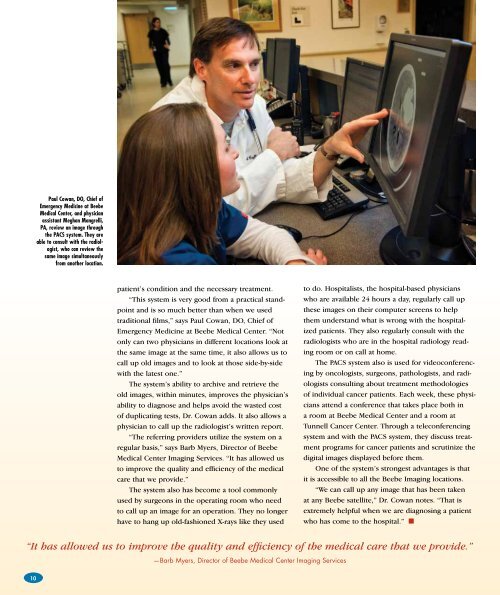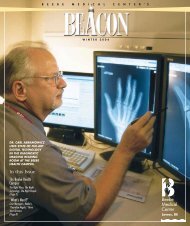ommunity - Beebe Medical Center
ommunity - Beebe Medical Center
ommunity - Beebe Medical Center
You also want an ePaper? Increase the reach of your titles
YUMPU automatically turns print PDFs into web optimized ePapers that Google loves.
Paul Cowan, DO, Chief of<br />
Emergency Medicine at <strong>Beebe</strong><br />
<strong>Medical</strong> <strong>Center</strong>, and physician<br />
assistant Meghan Mangrelli,<br />
PA, review an image through<br />
the PACS system. They are<br />
able to consult with the radiologist,<br />
who can review the<br />
same image simultaneously<br />
from another location.<br />
patient’s condition and the necessary treatment.<br />
“This system is very good from a practical standpoint<br />
and is so much better than when we used<br />
traditional films,” says Paul Cowan, DO, Chief of<br />
Emergency Medicine at <strong>Beebe</strong> <strong>Medical</strong> <strong>Center</strong>. “Not<br />
only can two physicians in different locations look at<br />
the same image at the same time, it also allows us to<br />
call up old images and to look at those side-by-side<br />
with the latest one.”<br />
The system’s ability to archive and retrieve the<br />
old images, within minutes, improves the physician’s<br />
ability to diagnose and helps avoid the wasted cost<br />
of duplicating tests, Dr. Cowan adds. It also allows a<br />
physician to call up the radiologist’s written report.<br />
“The referring providers utilize the system on a<br />
regular basis,” says Barb Myers, Director of <strong>Beebe</strong><br />
<strong>Medical</strong> <strong>Center</strong> Imaging Services. “It has allowed us<br />
to improve the quality and efficiency of the medical<br />
care that we provide.”<br />
The system also has become a tool commonly<br />
used by surgeons in the operating room who need<br />
to call up an image for an operation. They no longer<br />
have to hang up old-fashioned X-rays like they used<br />
to do. Hospitalists, the hospital-based physicians<br />
who are available 24 hours a day, regularly call up<br />
these images on their computer screens to help<br />
them understand what is wrong with the hospitalized<br />
patients. They also regularly consult with the<br />
radiologists who are in the hospital radiology reading<br />
room or on call at home.<br />
The PACS system also is used for videoconferencing<br />
by oncologists, surgeons, pathologists, and radiologists<br />
consulting about treatment methodologies<br />
of individual cancer patients. Each week, these physicians<br />
attend a conference that takes place both in<br />
a room at <strong>Beebe</strong> <strong>Medical</strong> <strong>Center</strong> and a room at<br />
Tunnell Cancer <strong>Center</strong>. Through a teleconferencing<br />
system and with the PACS system, they discuss treatment<br />
programs for cancer patients and scrutinize the<br />
digital images displayed before them.<br />
One of the system’s strongest advantages is that<br />
it is accessible to all the <strong>Beebe</strong> Imaging locations.<br />
“We can call up any image that has been taken<br />
at any <strong>Beebe</strong> satellite,” Dr. Cowan notes. “That is<br />
extremely helpful when we are diagnosing a patient<br />
who has come to the hospital.” n<br />
“It has allowed us to improve the quality and efficiency of the medical care that we provide.”<br />
—Barb Myers, Director of <strong>Beebe</strong> <strong>Medical</strong> <strong>Center</strong> Imaging Services<br />
10








